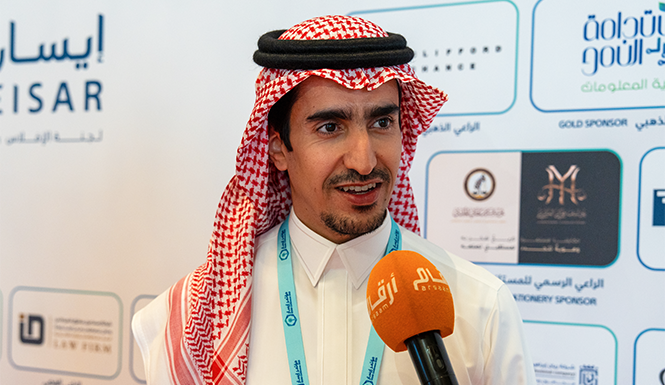Saudi Arabia’s Bankruptcy Law — supported by other regulatory measures enacted under Vision 2030 — is deemed a “qualitative leap” in the framework for treating corporate debt, legal experts told Argaam.
Speaking on the sidelines of the ISAR 2025 Conference, experts said these frameworks are crucial for safeguarding corporates against potential financial distress, enabling future forecasting to pre-empt future bankruptcy filings.
The new system is tailored to ease procedural burdens on distressed firms, effectively translating financial adversity into genuine prospects for growth and renewed profitability, they continued.
Analysts also pointed to several key causes of corporate default, including excessive borrowing, force majeure events such as the COVID-19 pandemic, weak governance, and flaws in internal oversight.
They explained that these internal organizational shortcomings, alongside a tendency towards over-leveraging debt, critically compromise business viability, regardless of the scale of the company — be it small, medium, or large.
Root Causes of Default
Abdulaziz Al Khorayef, Founder of Al Khorayef Law Firm, identified several contributing factors to corporate default. These include the over-extension of borrowing and debt accumulation, the force majeure impact of COVID-19, inadequate governance structures, and the absence of legislative protocols within some firms, alongside various company-specific internal issues.

Abdulaziz bin Mohammed Al-Khorayef, owner of Alkhorayef Law Firm
He added that the electronic declaration listing of the Bankruptcy Committee showed that enterprises of all sizes —large, medium, and small — are affected, as excessive borrowing and governance gaps profoundly harm business operations across the board.
Besides, Al Khorayef characterized the bankruptcy sector as a promising industry, drawing in numerous professional and legal entities.
He noted that listed and family-owned companies are demonstrating greater awareness and proactivity in default predication. This heightened readiness allows them to take preemptive actions such as initiating preventive settlements and financial restructuring, thereby avoiding liquidation or definitive business shutdowns.

Ebrahim Alshareef, lawyer and bankruptcy trustee at Alshareef, Halawani, Al-Farsi & Qashlan (SHF&Q)
For his part, Ebrahim Alshareef, lawyer and bankruptcy trustee at Alshareef, Halawani, Al-Farsi & Qashlan (SHF&Q), said the firm is currently handling around 17 active bankruptcy-related procedures. The proceedings range across financial restructuring, liquidation, and small-debtor cases. Companies of varying sizes — small, medium, and large — are involved, with some cases each constituting more than 170 creditors and assets exceeding SAR 100 million.
He noted that the distressed companies span multiple sectors, including industrial, construction, real estate, commercial, and services, with concrete and building materials providers emphasized among those in liquidation.
However, Alshareef highlighted the industrial and contracting sectors as facing greater difficulties compared to others.
Regarding Saudi Arabia’s legislative framework, Al Khorayef said the Bankruptcy Law, issued in 1439 AH, represents a qualitative transformation in debt treatment legislation, which previously only covered insolvency cases.
The current law and its regulations form a comprehensive framework designed to ward off corporate risks and enable early forecasting to circumvent bankruptcy filings, he further stated.
Modernizing Debt Laws
Alshareef emphasized that, under the Saudi Vision 2030, the government has enacted a range of legislative reforms to empower financially challenged companies to transform obstacles into opportunities for renewed growth and profitability.
He elaborated on the Bankruptcy Law's versatility, offering various procedures for all corporate sizes — from preventive settlements to financial restructuring.
Successful resolution allows a company to exit the procedure and return to business as usual. Meanwhile, for those beyond salvage, the system provides for efficient bankruptcy or liquidation, ensuring the expedited disposal of assets and supporting their reintegration into the economy.
The integration of systems across the Ministries of Justice and Commerce is a key enabler. They facilitate the lifting of account seizures and the suspension of claims once a procedure is initiated.
The system benefits from a claims suspension that halts all legal actions against the company or its assets for up to 180 days, extendable if needed.
Additionally, the government has built advanced digital systems to streamline the implementation of these frameworks, halting enforcement actions when a bankruptcy case is opened, thereby supporting companies in drafting and passing their recovery proposals.
Alshareef contrasted this with the past, where liquidation was either voluntary — if the company was able to repay its debts —or judicial through the courts. However, the former lengthy judicial liquidation often froze assets and eroded their value.
The current Bankruptcy Law has accelerated procedures, with mechanisms established to develop and certify bankruptcy trustees, while also enhancing their professional and technical skills within the judicial system — a critical step in achieving the Saudi Vision 2030 goals for judicial efficiency and system activation.
Be the first to comment


Comments Analysis: